Is Rose Rosette Virus still taking its toll?
This past spring had roses looking better than they have for the past 10 or 15 years. At least that was my observation where we live in North Central Texas.
Around DFW, all species and cultivars of roses have been devastated by the fatal virus that’s spread by an invisible mite. It seemed like all the cards were truly stacked against us.

This is not a new thing. The virus was first detected in the Rocky Mountains 80 years ago. Since that time, it’s made its way across the country, the continent, and around the globe. It’s had some of us wondering if we would ever be able to celebrate the Queen of Flowers again.

It’s been remarkable watching the incredible outpouring of talent that’s been directed at finding solutions to Rose Rosette Virus (RRV), also commonly referred to as Rose Rosette Disease (RRD). Large public and private grants, university partnerships, and industry initiatives, plus massive educational programs have been assembled against it. Yet the microscopic mite and the disease that it carries persist.
I thought our time here might best be served by listing the symptoms to help you identify whether your roses might be infected, then by detailing how you should deal with them if they should. Finally, I’m going to provide you links to many of the main articles that have been written about RRV so that you can glean more details from those who know this dreaded disease best.
The key symptoms of Rose Rosette Virus RRV
Here are the things you’ll want to watch for.
• Extremely strong stalks (“bull” canes) growing out of otherwise normal plants.
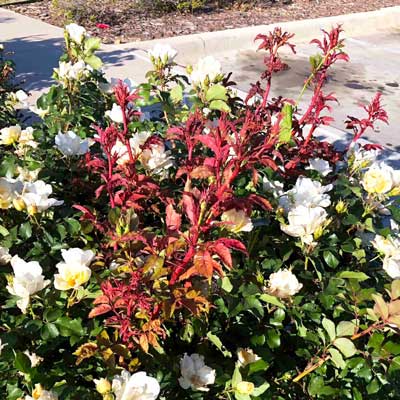
• Flower buds that fail to open properly and that become misshapen.
• “Witches’ broom” effect of stem growth, giving rise to the name “rosette.”
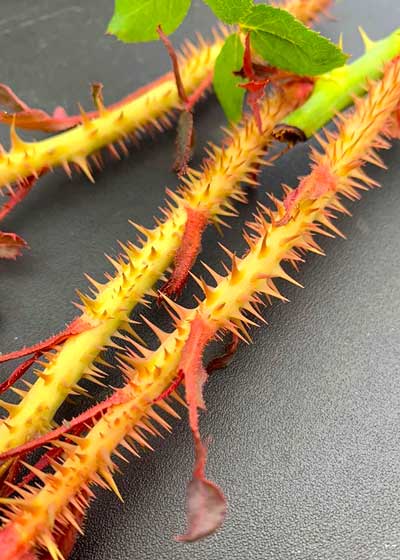
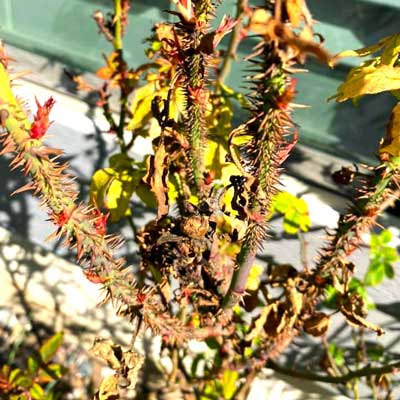
Perhaps the most graphic difference in healthy and diseased roses will be in the canes. RRV rose plants will have 10 to 20 times the number of prickles (not actually thorns) compared to normal, healthy canes.
• Extreme thorniness of some individual canes – 10 or 20 times the normal number of prickles.
• Leaf distortion that might be confused with herbicide damage. Those distorted leaves may also be discolored yellow. Also, remember that herbicide drift, if it were responsible, would probably also be impacting plants other than the roses in the immediate area.
• Weak branches browning and dying.
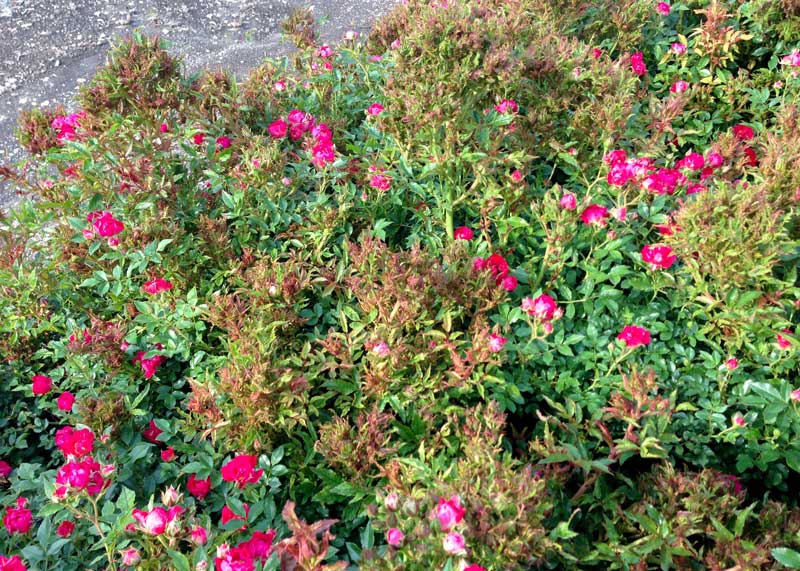
• Plants dying completely within 1 to 2 years.
• All parts of the plant are infected. Pruning out obviously infected portions will not help. The rest of the plant, even seemingly healthy, will serve to spread the disease.

What to do if you have infected plants
This part is sadly simple. Once you are certain that a plant is infected, you need to dig it carefully – remove it – roots and all and place it in a large trash bag. Send it to the landfill so that all diseased portions as well as the mites will be removed from your landscape and your neighborhood. Do this as soon as possible so you do not further contaminate other roses nearby.
Wait several months, up to 1-2 years before replanting roses into that area. The disease will be gone, but you want to make sure there is no source of reinfection nearby.
As you replant, allow more space between plants. Many feel that the rapid spread of the disease in urban areas has been facilitated by large-scale landscape plantings of Knockout® roses plant-against-plant. Separate your new roses with other unrelated species to slow the spread should RRV crop up again.
Note: If you are unsure of whether your plants have RRV, do not take samples in to a nursery. They don’t want them near their healthy plants. Take good, clear photos instead. Look for a Texas Certified Nursery Professional. He or she will have seen enough RRV to know it right away. Or pack samples in plastic bags and put them in an ice chest. Ask that a Certified Nursery Professional take a look in the car.
What others have written about RRV/RRD
It’s best to see what Land Grant Universities have written about various topics. I grew up with a Texas A&M professor as my dad, so I know what objective and detailed research looks like. Look also at what a plant’s staunch advocates say – those who are members of its societies and those who produce it for a living.
Here are some of the more informative websites dealing with Rose Rosette Virus, also known as Rose Rosette Disease.
From Oklahoma State
https://extension.okstate.edu/fact-sheets/rose-rosette-disease.html
From Clemson University
https://hgic.clemson.edu/factsheet/frequently-asked-question-about-rose-rosette-virus/
From Texas A&M, details of renewed efforts nationally
https://agrilifetoday.tamu.edu/2022/10/06/new-research-tackles-rose-rosette-black-spot-diseases/
From Michigan State University
https://www.canr.msu.edu/news/rose_gardeners_should_learn_the_symptoms_of_rose_rosette_virus
From North Carolina State University
https://lee.ces.ncsu.edu/2022/05/rose-rosette-disease/
And, if all those were too simplistic for you, this from the American Phytopathological Society
https://apsjournals.apsnet.org/doi/10.1094/PHP-05-22-0047-DG
The sum of all this information is that all species and cultivars of roses are susceptible to Rose Rosette Virus. We still have no prevention or cure for the virus. We have no miticide that will stop the vector of the disease. All we can do is remove infected plants, replant as we are willing, and wait for new developments.
Are there other plants we might use?
I’m asked all the time, “Neil, what would recommend to replace our roses? What looks about the same?”
Unfortunately, no plant looks like a rose except another rose. But if you’re willing to trade for an attractive plant that would add landscaping interest, I do have good suggestions.
If you simply want to use shrubs for their continuity of good looks, the best would be dwarf hollies, nandinas dwarf abelias, low junipers, and other woody plants adapted to your part of Texas. Your local independent garden center will have many good options.
Perennials are another good choice, especially if you’re seeking color in the old rose bed. There are scores of types from which to choose. Select varieties that will give you a nice sequence of blooms. Be mindful of their flowering times, mature heights, and colors. It’s wise to plant a few evergreen woody plants to anchor the bed visually during the winter dormant season.
Annuals are quick and easy. They’re also affordable, and most will be colorful for five or six months at a time. Determine what height you want your annuals to grow and what colors you want, then let your nursery professional suggest some of the best. As with perennials, the bed will look better if you anchor it with a few evergreen shrubs.
I had a revelation…
All of that said, I was running errands a few years ago when I saw a planting that struck me as the perfect replacement for Knockout® red roses.

Dwarf crape myrtles bloom for several months and in more or less the same colors as roses. Both plants are deciduous, and they grow to be about the same height. Choose whichever you like from the ones you find in the nursery, but for me, I’m willing to search for the Petite series introduced in the 1960s and still going strong. They grow to 4 ft. tall and wide and they’re available in deep red, rose red, pink, purple, lavender, and white.
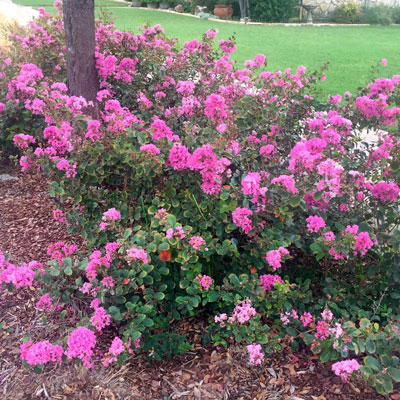
Note: You can treat the Petite crape myrtles almost like perennials. Much as you would prune roses or autumn sage back by half in late winter, you can do the same with Petite crape myrtles. That trimming will force new growth and generous quantities of flowers. (But please don’t ever top tree-form crape myrtles.)
